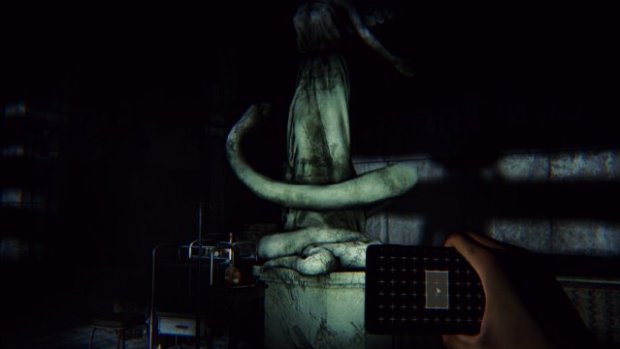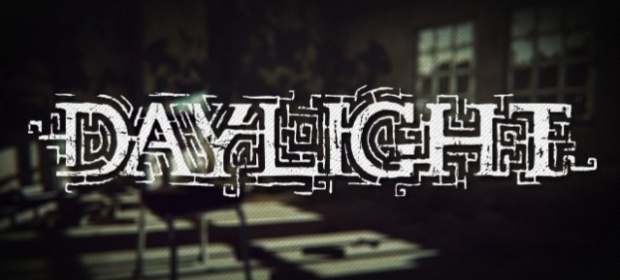Some people love a good scare, and some people hate them. Others treat a scare like an adorable kid kicking them in the shin: they want to hate it, but can’t help but love it. Daylight is that adorable kid: a game that makes you want to run away from the screen but keeps you coming back for more. Developed by Zombie Studios, Daylight is a pillar in the current resurgence of horror games these past few years have seen.
Waking up in a hospital, protagonist Sarah, armed with only a cell phone as both her map and light, must find “remnants” and try to escape. Taking control, you must find your way through various creepy locations with little else but glow-sticks and flares. The remnants are documents – letters and pictures that reveal the secrets of the now-abandoned hospital and give you a wider knowledge of its history. Once the remnants have been collected, you must then find the sigil (key) to unlock the door and move closer to your escape. More important than being merely informative, remnants will increase the threat level in the game, making enemies more likely to appear – in a similar vein to how collecting the notes in Slenderman make him appear more and more often. Because you don’t have access to any weapons to fight the enemies, known as “Shadow People”, you are left with two options: use a flare to get rid of them or run away.

As you progress through the game, the intensity levels grow tremendously. With equally eerie visuals and sound, Zombie Studios create a profound yet subtly intimidating atmosphere that immerses you as it gears up to scare you half to death at every unexpected moment. While any sound could be a Shadow Person, it could also be nothing; once the map on your phone begins to crackle and lose reception, you know that what’s next is not something you want to be a part of. You will become flustered and confused, especially when the Shadow People show up and disrupt your concentration – exactly what horror games should do. To be successful, you will need to keep your composure and stay collected when push comes to shove – easier said than done. That’s what makes a horror game a good horror game – it doesn’t just scare you, it affects the way in which you play, whether you play with more care than before, or simply become very apprehensive.
The level design is a major factor in Daylight. Without giving anything away, you will find yourself in a sewer at one point, and once you’re confined to a small catwalk, claustrophobia starts to kick in. Once a few remnants have been collected and Shadow People start to emerge, escaping becomes a much more difficult task – even more so when you discover that you have no flares left. It plays into the “don’t look back” mentality you experience in horror movies. Why do people waste their time and look back in those movies? Why don’t they keep running? You will gain a strong understanding of that when playing this game. That is the brilliance of Daylight: it toys with your emotions, it makes you anxious, it affects your mind-set and changes the way you play the game.

The charm of Daylight, however, is that no two playthroughs are the same. Each time you start it up, your experience will be different. It was a necessary feature for an important reason: that if you could memorise where each scare is, the game would become less involving; the jump scares and the frantic panicking are Daylight’s driving forces. Because each time isn’t the same as the last, you can go back and have a new experience whenever you want. I had my first big scare in a particular room, and when I loaded the game back up again, I went back into the same room prepared for what I thought was coming and instead, Daylight caught me when I least expected it and forced yet another trip to the bathroom.The game isn’t too long so the replay value is a crucial aspect; had Daylight been the same the whole way through each time, that value would diminish quickly, so for that, Zombie Studios deserve high praise.
[notice]After playing Daylight on the PS4, we noticed a few small differences between that and the PC version. Nothing too major, but they can be the deciding factor for a person torn on both sides. The PS4 version did tend to jump and lag a bit. The darkness is a lot more effective than on the PC version. It feels a lot more claustrophobic on the PS4, which is great, as that is the sort of feeling you want to experience to improve the overall impact of the game. You would need to be almost right beside something before you can see it. Even with the glow sticks and flares, although they help, it still is very frightening and eerie. Shadow People spawned a lot more than they did on PC, which also makes the game seem more scarier than it’s other version. That isn’t taking anything away from the PC version, by any means. You will just have your heart beating a lot more if you are to play on the PS4. The PS4 does have issues when running. It’s not reoccurring but it can sometimes become frustrating, especially if you need everything to be fluid to escape from an enemy. It looks fantastic and contains more terror than the PC game. [/notice]
VERDICT: Daylight is one of the best in its class. It is a game that encapsulates the spirit of horror in any form of media and offers suspense, terror, panic and a mystery to solve. The procedurally-generated levels and fantastic design not only make the game challenging, but create an intense and energetic atmosphere, aided by the sparse resources that must be painstakingly preserved for that crucial, life-or-death moment. Everything about Daylight converges to create a shining beacon in the survival horror genre and shows a glimmer of hope for its future. If nothing else, one thing is for sure: it reassures you that your heart is working.

VERY GOOD. An 8/10 is only awarded to a game we consider truly worthy of your hard-earned cash. This game is only held back by a smattering of minor or middling issues and comes highly recommended.
Review code provided by publisher.





